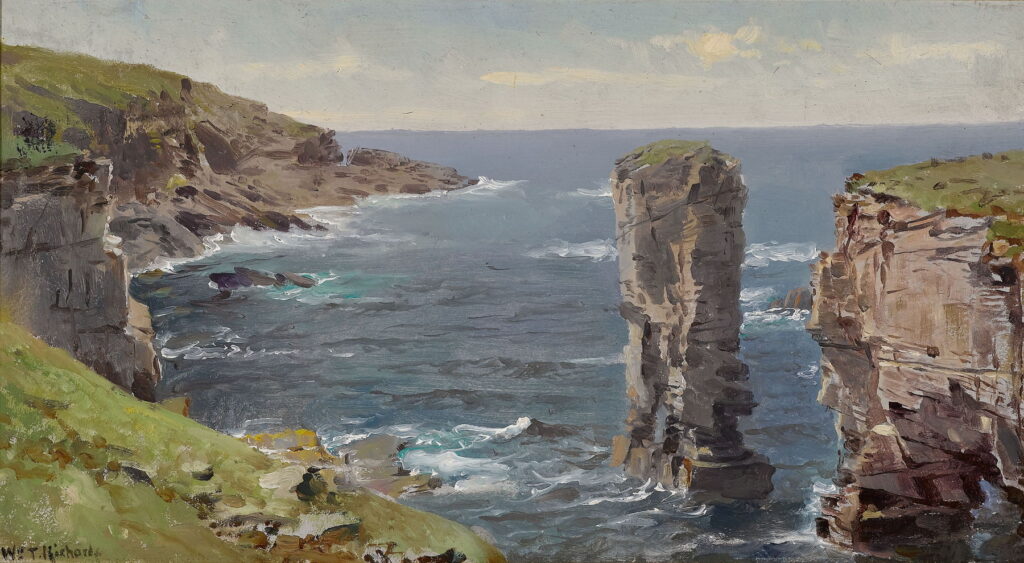Cornish Riviera Express: Paintings of the Cornish Coast 2

At the end of the nineteenth century, Cornwall and its marvellous coast was within easy reach of London, and its artist’s colony centred on Newlyn was growing in fame and size.
Abbott Handerson Thayer (1849–1921), Cornish Headlands (1898), oil on canvas, 76.5 x 101.9 cm, Smithsonian American Art Museum, Washington, DC. Wikimedia Commons.
The fame of the colonies in Cornwall spread internationally. In 1898, Abbott Handerson Thayer travelled from the East Coast of the US with a letter of introduction requesting permission to collect specimens of birds from the cliffs around St Ives. When not collecting those specimens, he painted views such as Cornish Headlands (1898).
Elizabeth Adela Forbes (1859–1912), Across Mounts Bay (date not known), watercolour, 32.3 x 45.7 cm, location not known. Wikimedia Commons.
Elizabeth Adela Forbes’s watercolour view Across Mounts Bay is another painting that may have been completed in front of the motif. This bay is on the southern, English Channel, coast of Cornwall, and became popular with painters during the late nineteenth century.
Charles Conder (1868–1909), The Sands, Newquay (c 1900), oil, dimensions and location not known. Wikimedia Commons.
Charles Conder, one of the Australian Impressionists, left Australia in 1890 for Europe. After a turbulent time in France, he came to Britain in the mid 1890s, and visited Cornwall. Although he engaged in bouts of heavy drinking and appeared sickly, his painting thrived, and some of his works from these years are among his best. This oil painting of The Sands, Newquay from about 1900 shows this beach now popular with surfers, and has long been famous for its sands. Conder’s health and work then deteriorated, and he was later admitted to a sanatorium, where he died in 1909.
John Reinhard Weguelin (1849–1927), The Mermaid of Zennor (1900), watercolour, dimensions and location not known. Wikimedia Commons.
John Reinhard Weguelin’s watercolour of The Mermaid of Zennor (1900) tells the legend of a mermaid living in a cove near Zennor. This scene brings her together with Matthew Trewhell, a local chorister, whose voice she had fallen in love with. The legend tells that the couple went to live in the sea, and that his voice can still be heard in the cove. Weguelin was a contemporary and follower of John William Waterhouse, although his alluring women were more frequently only scantily clad, or nude, and didn’t normally have fishtails either.
George Gardner Symons (1861–1930), Fishing Village, St. Ives (date not known), oil on canvas, 64.1 × 76.5 cm, Private collection. Wikimedia Commons.
George Gardner Symons is almost forgotten now, but in the late nineteenth century was a notable American Impressionist, specialising in plein air landscapes. He moved to Laguna Beach, California, in the early twentieth century. He studied in Europe, and at some time must have visited Cornwall, where he painted this undated view of the Fishing Village, St. Ives, showing the town’s harbour.
William Trost Richards (1833–1905), British Coastal View (Coast of Cornwall) (c 1880), oil on paper mounted on board, 22.2 × 40.6 cm, location not known. Wikimedia Commons.
William Trost Richards was another acclaimed American landscape artist associated with the Hudson River School. He first visited Britain in 1866, and seems to have returned on more than one occasion afterwards. His British Coastal View (Coast of Cornwall), from about 1880, shows one of the many small coves carved out from the rocky coast, with a sheer rock stack standing free of the cliff at the right.
William Trost Richards (1833–1905), Rocky Cliff with Stormy Sea, Cornwall (1902), oil on canvas, 45.7 x 61.0 cm, location not known. Wikimedia Commons.
Richards’ Rocky Cliff with Stormy Sea, Cornwall (1902) is reminiscent of the dramatic views of Clarkson Stanfield from almost a century before.
William Trost Richards (1833–1905), Off the Coast of Cornwall (1904), oil on canvas, 55.9 × 91.4 cm, location not known. Wikimedia Commons.
Painted only a year or so prior to his death, Richards’ Off the Coast of Cornwall (1904) is also very Stanfield in its use of light and dramatic waves breaking at the foot of the cliffs.
My two remaining artists were both brought up in Cornwall, and both became members of the Newlyn School.
Harold Harvey (1874–1941), Unloading the Boats, Newlyn Harbour (1906), oil on canvas, 30.5 × 46 cm, location not known. Wikimedia Commons.
Harold Harvey trained at the Penzance School of Arts under Norman Garstin, whose work I showed in the previous article. After two years at the Académie Julian in Paris, and shorter periods at other academies there, he returned to paint in his native Cornwall. He was a leading member of the Newlyn School, and co-founded an art school in the town. Unloading the Boats, Newlyn Harbour (1906) shows the intense manual handling required to unload the catch from small fishing boats in the harbour at that time, with carts being drawn through the water to get alongside the vessels.
Harold Harvey (1874–1941), The Old Slip, Newlyn (1908), oil on canvas, 30.4 x 45.7 cm, location not known. Wikimedia Commons.
Harvey’s The Old Slip, Newlyn (1908) shows the waterfront in brighter conditions, with work proceeding at a less frenetic pace.
Henry Scott Tuke (1858–1929), Windjammers Lying in the Carrick Roads above Falmouth (date not known), watercolor, 13 × 20.5 cm, location not known. Wikimedia Commons.
Henry Scott Tuke moved with his family to Falmouth, then trained at the Slade School of Art in London. Between 1880-83 he travelled in Italy and France, before returning to the colony at Newlyn. He was a prolific painter, specialising in nude boys bathing, but also painted some fine views of scenes on the Cornish coast.
His undated watercolour view of Windjammers Lying in the Carrick Roads above Falmouth shows two of the high-speed trading ships then reaching the end of their working lives. When entering the English Channel from the Western Approaches, Falmouth is the first major port on the north coast of the Channel, and has specialised in ship repair. Its sheltered waters of Carrick Roads, the estuary of the River Fal to the north of the port, remain a popular area for laying up vessels when out of service.
Henry Scott Tuke (1858–1929), Baiting a Spiller (1922), watercolor, 20 × 27.5 cm, location not known. Wikimedia Commons.
Tuke’s watercolour of Baiting a Spiller from 1922 shows a fisherman baiting a long fishing line with multiple hooks (a spiller, in Cornish dialect), on a beach near Swanpool, Falmouth. This was shown, together with another painting of his depicting fishing, at the winter exhibition of the Royal Watercolour Society in 1922. Owing to a misprint on the label of this painting, it’s sometimes known as Bailing a Spiller, which as far as I can tell makes no sense, even in Cornish dialect.
Cornwall and its famous coastline continue to play an important part in painting today.
Reference
The Newlyn School on Wikipedia.



